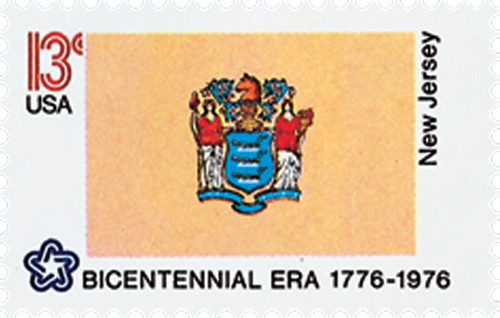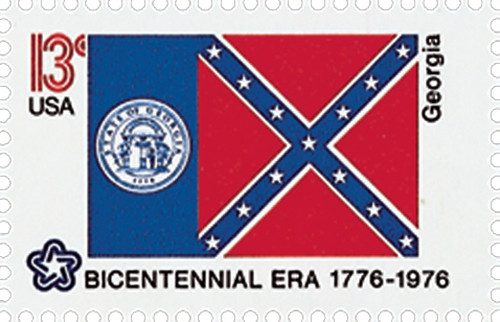
# 1647 - 1976 13c State Flags: Kentucky
U.S. 1647
1976 Kentucky Flag
State Flags
American Bicentennial Series
• First time a sheet 50 had all different stamp designs
• Part of the American Bicentennial Series
Stamp Category: Commemorative
Series: American Bicentennial Series
Value: 13¢ First-class postage rate
First Day of Issue: February 23, 1976
First Day City(s): Washington, DC
Quantity Issued: 8,720,100 (panes of 50)
Printed by: Bureau of Engraving and Printing
Printing Method: Photogravure
Format: Sheet of 50
Perforations: 11
Why the stamp was issued:
The United States Postal Service celebrated the American Bicentennial with a full pane of the Union’s fifty state flags.
About the stamp design:
During the Revolutionary War, Kentucky was a “dark and bloody ground.” Settlements were frequently under attack by British and Native American forces. Refusing to back down, Kentuckians formed a militia to fight for their freedom.
Kentucky was a border state at the start of the American Revolution. Secluded in the western wilderness, it was difficult to defend from attack. Native American war parties, led by British Rangers, sacked outposts and massacred hundreds of colonists. By the end of 1776, fewer than 200 settlers remained in the colony.
Kentucky pioneers were hardened by years of surviving in the wilds. Fighting alongside men such as Daniel Boone, the militia used the hit-and-run tactics of their enemy. After six years of bloody battles, Kentuckians secured the American frontier.
Over 150 years later, the Kentucky Historical Society hired art teacher Jessie Cox Burgess to design the state flag. Emblazoned on the flag was the state motto, “United We Stand, Divided We Fall.” The motto came from the lyrics of an American Revolutionary War song and forever reminds people of the brave settlers of Kentucky.
About the printing process:
Printed by the Bureau of Engraving and Printing on their seven-color Andreotti gravure press (601) which was their work horse for multicolored stamps.
About the American Bicentennial Series:
In the 1970s, America celebrated its 200th anniversary with hundreds of national events commemorating the heroes and historic events that led to our nation’s independence from Great Britain. The U.S. Postal Service issued 113 commemorative stamps over a six-year period in honor of the U.S. bicentennial, beginning with the American Revolution Bicentennial Commission Emblem stamp (U.S. #1432). As a group, the Bicentennial Series chronicles one of our nation’s most important chapters, and remembers the events and patriots who made the U.S. a world model for liberty.
Several of the stamps honored colonial life – craftsmen and communication. Other stamps honored important battles including Lexington and Concord, Bunker Hill, and Saratoga. Significant events such as the Boston Tea Party, the meeting of the First Continental Congress, and the Declaration of Independence were featured as well. The stamps also honored many significant people such as George Washington, Sybil Ludington, Salem Poor, and the Marquis de Lafayette.
Many of the stamps feature classic artwork. For instance, the set of four souvenir sheets picture important events recreated by noted artists such as John Trumbull. The Bicentennial Series also includes an important US postal first – the first 50-stamp se-tenant – featuring all 50 state flags. The format proved to be popular with collectors, and has been repeated many times since.
The American Bicentennial Series is packed with important US history – it tells the story of our nation’s fight for independence through stamps.
History the stamp represents:
On June 1, 1792, Kentucky was admitted as America’s 15th state.
Indians lived in the forested areas of western Kentucky many thousands of years ago. When Europeans reached the area there were a number of Indian tribes living there, including the Cherokee, Delaware, Iroquois, and Shawnee.
During the late 1600s and early 1700s, many explorers from England and France traveled through the region. The English explorers included Colonel Abraham Wood, Gabriel Arthur, and John P. Salling. Father Jacques Marquette, Louis Jolliet, and Robert Cavelier explored the area for France.
In 1750, Thomas Walker conducted the first extensive European exploration of the eastern portion of Kentucky. The legendary Daniel Boone explored eastern Kentucky in 1767, and again in 1769, when he spent two years living in the Bluegrass region. In 1773, Boone attempted to lead a group of settlers into the area, but Indians prevented it. In 1774, a group of colonists from Pennsylvania, led by James Harrod, established the first permanent white settlement in Kentucky, called Harrodsburg. Soon after, Boone established Boonesborough along the Kentucky River. The route Boone took into Kentucky became known as the “Wilderness Road.”
Separated from the American colonies by mountains and forests, Kentucky was very remote. As the American Revolution raged in the colonies, Kentucky was left susceptible to attacks from Indians who were armed by the British. Under the capable leadership of Boone, Simon Kenton, and George Rogers Clark, the Kentucky settlers were able to defend themselves. In 1776, Kentucky became a county of Virginia. Many settlers from Virginia moved to the area, which prompted an increase in Indian attacks. In 1778, George Rogers Clark led a small group of colonists against the British settlements responsible for supplying arms to the Indians. This action was successful, and greatly reduced the number of attacks against the Kentucky colonists.
In May 1792, Kentucky adopted a constitution and prepared for statehood, which was achieved June 1, 1792. Isaac Shelby, a hero of the Revolutionary War, helped to frame Kentucky’s constitution and became the state’s first governor.
U.S. 1647
1976 Kentucky Flag
State Flags
American Bicentennial Series
• First time a sheet 50 had all different stamp designs
• Part of the American Bicentennial Series
Stamp Category: Commemorative
Series: American Bicentennial Series
Value: 13¢ First-class postage rate
First Day of Issue: February 23, 1976
First Day City(s): Washington, DC
Quantity Issued: 8,720,100 (panes of 50)
Printed by: Bureau of Engraving and Printing
Printing Method: Photogravure
Format: Sheet of 50
Perforations: 11
Why the stamp was issued:
The United States Postal Service celebrated the American Bicentennial with a full pane of the Union’s fifty state flags.
About the stamp design:
During the Revolutionary War, Kentucky was a “dark and bloody ground.” Settlements were frequently under attack by British and Native American forces. Refusing to back down, Kentuckians formed a militia to fight for their freedom.
Kentucky was a border state at the start of the American Revolution. Secluded in the western wilderness, it was difficult to defend from attack. Native American war parties, led by British Rangers, sacked outposts and massacred hundreds of colonists. By the end of 1776, fewer than 200 settlers remained in the colony.
Kentucky pioneers were hardened by years of surviving in the wilds. Fighting alongside men such as Daniel Boone, the militia used the hit-and-run tactics of their enemy. After six years of bloody battles, Kentuckians secured the American frontier.
Over 150 years later, the Kentucky Historical Society hired art teacher Jessie Cox Burgess to design the state flag. Emblazoned on the flag was the state motto, “United We Stand, Divided We Fall.” The motto came from the lyrics of an American Revolutionary War song and forever reminds people of the brave settlers of Kentucky.
About the printing process:
Printed by the Bureau of Engraving and Printing on their seven-color Andreotti gravure press (601) which was their work horse for multicolored stamps.
About the American Bicentennial Series:
In the 1970s, America celebrated its 200th anniversary with hundreds of national events commemorating the heroes and historic events that led to our nation’s independence from Great Britain. The U.S. Postal Service issued 113 commemorative stamps over a six-year period in honor of the U.S. bicentennial, beginning with the American Revolution Bicentennial Commission Emblem stamp (U.S. #1432). As a group, the Bicentennial Series chronicles one of our nation’s most important chapters, and remembers the events and patriots who made the U.S. a world model for liberty.
Several of the stamps honored colonial life – craftsmen and communication. Other stamps honored important battles including Lexington and Concord, Bunker Hill, and Saratoga. Significant events such as the Boston Tea Party, the meeting of the First Continental Congress, and the Declaration of Independence were featured as well. The stamps also honored many significant people such as George Washington, Sybil Ludington, Salem Poor, and the Marquis de Lafayette.
Many of the stamps feature classic artwork. For instance, the set of four souvenir sheets picture important events recreated by noted artists such as John Trumbull. The Bicentennial Series also includes an important US postal first – the first 50-stamp se-tenant – featuring all 50 state flags. The format proved to be popular with collectors, and has been repeated many times since.
The American Bicentennial Series is packed with important US history – it tells the story of our nation’s fight for independence through stamps.
History the stamp represents:
On June 1, 1792, Kentucky was admitted as America’s 15th state.
Indians lived in the forested areas of western Kentucky many thousands of years ago. When Europeans reached the area there were a number of Indian tribes living there, including the Cherokee, Delaware, Iroquois, and Shawnee.
During the late 1600s and early 1700s, many explorers from England and France traveled through the region. The English explorers included Colonel Abraham Wood, Gabriel Arthur, and John P. Salling. Father Jacques Marquette, Louis Jolliet, and Robert Cavelier explored the area for France.
In 1750, Thomas Walker conducted the first extensive European exploration of the eastern portion of Kentucky. The legendary Daniel Boone explored eastern Kentucky in 1767, and again in 1769, when he spent two years living in the Bluegrass region. In 1773, Boone attempted to lead a group of settlers into the area, but Indians prevented it. In 1774, a group of colonists from Pennsylvania, led by James Harrod, established the first permanent white settlement in Kentucky, called Harrodsburg. Soon after, Boone established Boonesborough along the Kentucky River. The route Boone took into Kentucky became known as the “Wilderness Road.”
Separated from the American colonies by mountains and forests, Kentucky was very remote. As the American Revolution raged in the colonies, Kentucky was left susceptible to attacks from Indians who were armed by the British. Under the capable leadership of Boone, Simon Kenton, and George Rogers Clark, the Kentucky settlers were able to defend themselves. In 1776, Kentucky became a county of Virginia. Many settlers from Virginia moved to the area, which prompted an increase in Indian attacks. In 1778, George Rogers Clark led a small group of colonists against the British settlements responsible for supplying arms to the Indians. This action was successful, and greatly reduced the number of attacks against the Kentucky colonists.
In May 1792, Kentucky adopted a constitution and prepared for statehood, which was achieved June 1, 1792. Isaac Shelby, a hero of the Revolutionary War, helped to frame Kentucky’s constitution and became the state’s first governor.

















